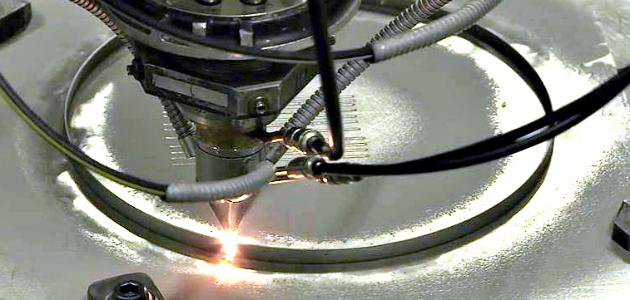Lloyd’s Register Energy Partners with TWI to Launch Two Collaborative Global Projects Focused on Industrial Additive Manufacturing Challenges
 Toward the end of 2014, Lloyd’s Register Energy (LR) announced a joint industry project (JIP) and asked companies all over the world to come together and discuss the issues manufacturers were dealing with through additive manufacturing techniques, as there was not a set way to prove that 3D printed products were safe. According to the London-based engineering, technical, and business services firm, the technology as a whole was being held back, due to a lack of industry standard benchmarks. The goal of the JIP was to study quality control, environmental hazards, digital data integrity, and software and hardware usability issues. Two years later, the company has teamed up with leading research and technology organization The Welding Institute (TWI) to launch two new collaborative projects that will help companies more fully integrate additive manufacturing.
Toward the end of 2014, Lloyd’s Register Energy (LR) announced a joint industry project (JIP) and asked companies all over the world to come together and discuss the issues manufacturers were dealing with through additive manufacturing techniques, as there was not a set way to prove that 3D printed products were safe. According to the London-based engineering, technical, and business services firm, the technology as a whole was being held back, due to a lack of industry standard benchmarks. The goal of the JIP was to study quality control, environmental hazards, digital data integrity, and software and hardware usability issues. Two years later, the company has teamed up with leading research and technology organization The Welding Institute (TWI) to launch two new collaborative projects that will help companies more fully integrate additive manufacturing.
 The companies are looking for more partners to join their global projects, which are focused on two major additive manufacturing challenges in the industrial sector: regulatory compliance and the joining of additively manufactured structures. The new projects will “further explore challenges uncovered from LR and TWI’s first joint industry project,” which was titled “Certification of Laser Powder Additive Manufactured Components for Industrial Adoption in the Energy and Offshore Sectors.” This 2015 project posited that additive manufacturing will grow 390% by the year 2022, but mentions again the lack of standards. These two new collaborative efforts, “Achieving Regulatory and Code Compliance for Additive Manufacturing” and “Joining of Metallic Additively Manufactured Products and Materials,” should have a lot of global companies very interested.
The companies are looking for more partners to join their global projects, which are focused on two major additive manufacturing challenges in the industrial sector: regulatory compliance and the joining of additively manufactured structures. The new projects will “further explore challenges uncovered from LR and TWI’s first joint industry project,” which was titled “Certification of Laser Powder Additive Manufactured Components for Industrial Adoption in the Energy and Offshore Sectors.” This 2015 project posited that additive manufacturing will grow 390% by the year 2022, but mentions again the lack of standards. These two new collaborative efforts, “Achieving Regulatory and Code Compliance for Additive Manufacturing” and “Joining of Metallic Additively Manufactured Products and Materials,” should have a lot of global companies very interested.
Both LR and TWI are already fairly involved with the additive manufacturing industry: both companies are members of several working additive manufacturing standardization groups. Even the owner of LR, non-profit Lloyd’s Register Foundation, is funding research programs that will address the safety challenges of additive manufacturing. These joint projects will help further involve both companies in the growing AM industry.
The aerospace and medical industries in particular have taken to AM, as the technology can create custom, precise, and complex metal parts that weigh less, while still maintaining a high material utilization. There is near constant research these days, even considering “the current market pressure in the maritime and energy industries,” especially into the production of 3D printed metal parts, as major industry names keep adding beneficial AM technologies to their wheelhouse, focusing on weight reduction and the ability to fabricate spare parts on demand.
 However, an aspect that still needs to be closely examined is “the link between additive manufacturing and compliance with standards and regulations that are often used in safety-critical pieces of equipment.” Some of these regulations and industry standards include the American Petroleum Institute Code (API), the American Society of Mechanical Engineer’s (ASME) Boiler and Pressure Vessel Code, and Europe’s Pressure Equipment Directive (PED).
However, an aspect that still needs to be closely examined is “the link between additive manufacturing and compliance with standards and regulations that are often used in safety-critical pieces of equipment.” Some of these regulations and industry standards include the American Petroleum Institute Code (API), the American Society of Mechanical Engineer’s (ASME) Boiler and Pressure Vessel Code, and Europe’s Pressure Equipment Directive (PED).
The first of LR and TWI’s new projects, “Achieving Regulatory and Code Compliance for Additive Manufacturing,” will “investigate the routes to regulatory compliance of parts selected by project sponsors, and will produce data and assessment criteria for the introduction and acceptance of parts through third-party inspection.” Some of the components and materials that will be investigated include mechanical properties, microstructural characteristics, and corrosion resistance and inspection. The research will give the project sponsors a leg up, as the companies will be able to get technical services and support, as well as more fully understand and appreciate the scope of existing standards and regulatory codes. According to the project page, the objectives of this JIP are:
- To investigate the methodology for potential acceptance of AM materials and begin the process of introducing AM to the relevant regulatory bodies;
- To generate specific material data including comparative microstructures and properties for a range of metallic engineering materials;
- To recommend methods for the inspection of AM parts;
- To provide guidance for the introduction of AM technology into manufacturing.
 The “Joining of Metallic Additively Manufactured Products and Materials” project will focus more on “filling in the real-world gaps (e.g. controls, data, testing, inspection) to enable project sponsors to design, fabricate and put into service structures that are comprised of conventionally made parts welded with additively manufactured parts.” The project will look more closely at the methods involved in joining additively manufactured parts, and assist project sponsors in gaining the necessary information, and confidence, to plan, design, and test additively manufactured parts in the real world at their own facilities. According to the project page, the objectives of this JIP are:
The “Joining of Metallic Additively Manufactured Products and Materials” project will focus more on “filling in the real-world gaps (e.g. controls, data, testing, inspection) to enable project sponsors to design, fabricate and put into service structures that are comprised of conventionally made parts welded with additively manufactured parts.” The project will look more closely at the methods involved in joining additively manufactured parts, and assist project sponsors in gaining the necessary information, and confidence, to plan, design, and test additively manufactured parts in the real world at their own facilities. According to the project page, the objectives of this JIP are:
- Design and manufacture standardized representative AM samples, for use in subsequent joining trials, in materials relevant to the requirements of the sponsor group;
- Make joints in AM material using the methods selected by the sponsor group, identify suitable processing methods and parameters;
- Assess the performance of non-destructive testing methods on joints containing AM materials;
- Perform testing to assess the properties of the joints and the efficacy of using standardized tests on AM material.
LR and TWI are still looking for project sponsors; if your company is interested, you can sign up on the project pages. The project launch meeting and presentations will be held next Tuesday, January 24th, at TWI’s head office in Cambridge, United Kingdom; you can also sign in via telephone or video conference. Discuss in the LR TWI forum at 3DPB.com.
Subscribe to Our Email Newsletter
Stay up-to-date on all the latest news from the 3D printing industry and receive information and offers from third party vendors.
Print Services
Upload your 3D Models and get them printed quickly and efficiently.
You May Also Like
Nikon SLM Solutions Sells SLM 500 to Primary Weapon Systems to Expand Suppressor Production
Primary Weapons Systems (PWS) is a Boise, Idaho-based manufacturer of suppressors, firearms, and related components. A subsidiary of Vigilant Gear and a sister company to aftermarket Glock slide manufacturer Lone...
3DPOD 261: Tooling and Cooling for AM with Jason Murphy, NXC MFG
Jason Murphy´s NXC MFG (Next Chapter Manufacturing) is not a generalist service; instead, the company specializes in making tooling. Using LPBF and binder jet, the company produces some of the...
HP and Firestorm Labs Form Partnership to Use Multi Jet Fusion 3D Printers in Deployable Factories
HP Inc., maker of a range of additive manufacturing (AM) solutions including the Multi Jet Fusion (MJF) ecosystem, has announced a partnership with Firestorm Labs, a developer of containerized, deployable...
3D Printing News Briefs, July 2, 2025: Copper Alloys, Defense Manufacturing, & More
We’re starting off with metals in today’s 3D Printing News Briefs, as Farsoon has unveiled a large-scale AM solution for copper alloys, and Meltio used its wire-laser metal solution to...
































